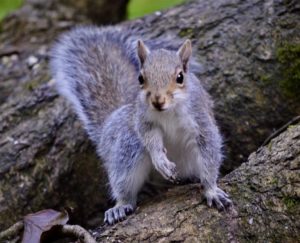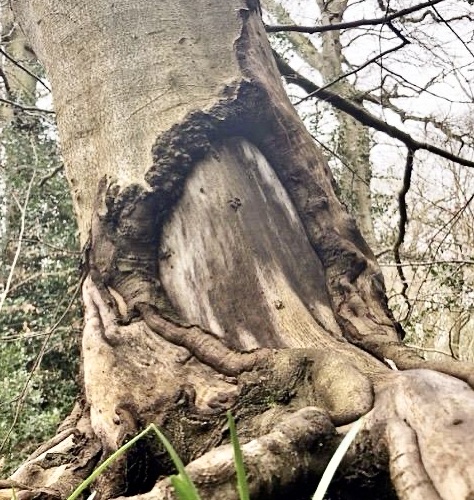Grey squirrel damage.

Much has been written about the explosion of the UK deer population in recent times, and the damage to woodlands through their browsing activities. However, the grey squirrelis associated with tree damage. The grey squirrel is not just the 'cheeky chap' who steals the bird food in the garden, it is a serious pest. The grey squirrel is a non-native species. It was introduced in the 19th century. The squirrels have spread across the country and have displaced the native red squirrel from many areas (either through competition or disease).
The grey squirrel's bark stripping activity now poses a threat to the sustainable management of woodlands. Gnawing of the bark means that they can get to the sweet, sap filled tissue (phloem) just beneath the bark. This tissue is responsible for the movement of sugars and other organic molecules around the plant (known as translocation). If the gnawing extends around the stem then the tree is ‘ringed’ [i.e a complete circle of bark and underlying tissue is removed] then the tree us likely to die. The squirrels tend to take bark from the main stem (and branches).
The bark stripping may :
- Lead to the loss of particular tree species (for example, beech)
- Lead to the loss of insect / spider and fungal species associated with the loss of tree species, i.e. a loss of biodiversity
- allow fungal infection of the tree
- Reduce carbon capture
- Reduce the economic value of timber
- Act as a disincentive to creating new woodland for timber
In order to reduce squirrel damage, it is important to
- Start inspecting for damage in late February as damage typically occurs in early Spring. Examine the base of trees for damage.
- Look for ‘tester patches’ made by squirrels (to which they may well return later).
- Check young, broadleaf trees as they are particularly favoured by the squirrels. Oak and beech are quite vulnerable to damage (see image of damaged beech trunk below).

Recent research* at Bangor University has investigated the microbiome of the squirrel in relation to its bark stripping activity. The microbiome of the gut refers to the various micro-organisms found with the intestines. Analysis of bacterial DNA found in the colon of great (and red) squirrels revealed that grey squirrels
- had 'oxalobacter' bacteria in their colons. These bacteria are able to 'release / access' calcium from the tree bark to the squirrels. Calcium is an important nutrient in terms of bone building and is also involved in muscle contraction.
- had a more diverse bacterial population in the colon.
These findings may help explain why the grey squirrel 'outcompetes' the red squirrel. Their more diverse gut microbiome may mean that they can access a greater range of resources. For example, grey squirrels can digest acorns, which red squirrels cannot; this is possibly associated with tannin content of acorns.
In order to reduce damage in a woodland, the number of grey squirrels may need to be managed. This can be done though trapping or shooting. Trapping is a legally acceptable and effective way of controlling grey squirrels in most situations.
 Grey squirrels can be trapped throughout the year though March to September is a good time as food is less abundant. Through autumn, berries, nuts and seeds [natural foods] are available so trapping is less successful.
Grey squirrels can be trapped throughout the year though March to September is a good time as food is less abundant. Through autumn, berries, nuts and seeds [natural foods] are available so trapping is less successful.
Details of the various types of traps and their use / placement may be found at:
- https://greysquirrelcontrol.co.uk/trapping-method.php
- https://www.britishredsquirrel.org/wp-content/uploads/2016/07/Grey-Squirrel-Best-Practice.pdf
- https://basc.org.uk/pest-and-predator-control/grey-squirrel-control-with-live-capture-traps/
- https://www.britishredsquirrel.org/wp-content/uploads/2016/09/Trapping-Protocol.pdf
- https://bpca.org.uk/a-z-of-pest-advice/squirrel-control-how-to-get-rid-of-squirrels-bpca-a-z-of-pests-/188983
To go down the ‘shoot to kill’ route then there are a number of rules and regulations to observe. Details may be found in the link below :
http://www.britishredsquirrel.org/grey-squirrels/grey-control/
It is hoped that eventually a form of oral contraception will be developed, which will offer a non-lethal and humane means of population control.
- Full details of this research work may be found here
Comments are closed for this post.
